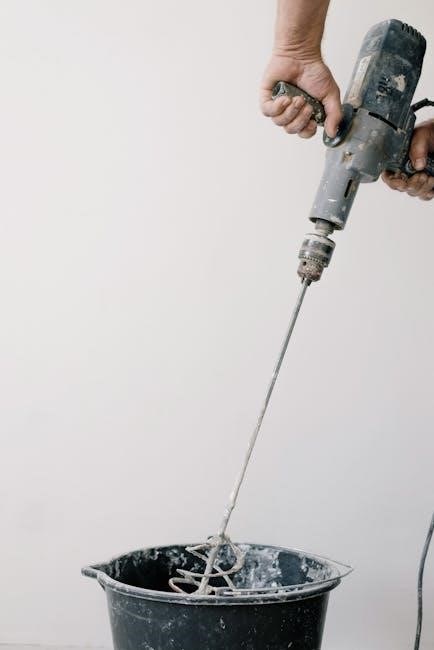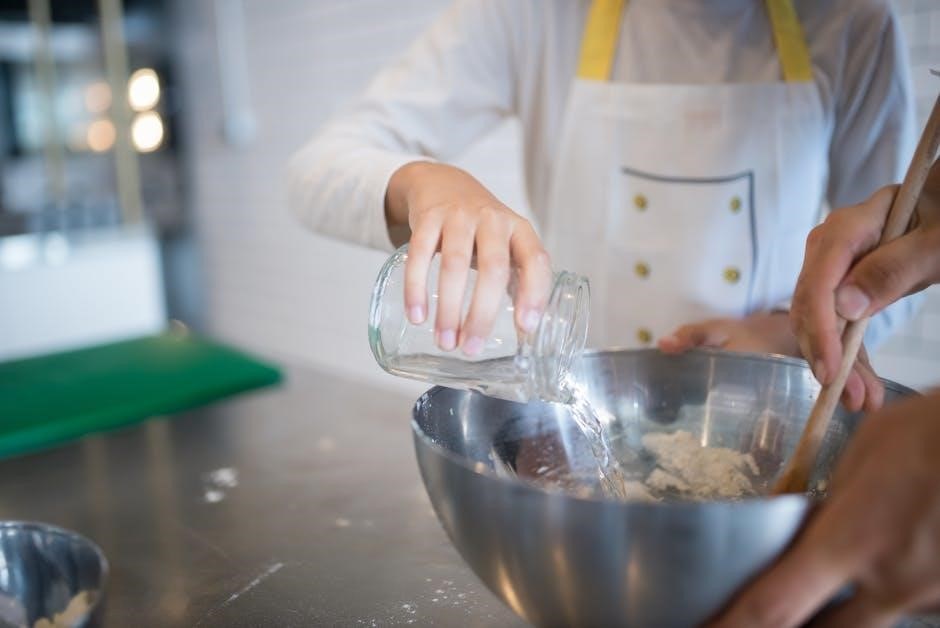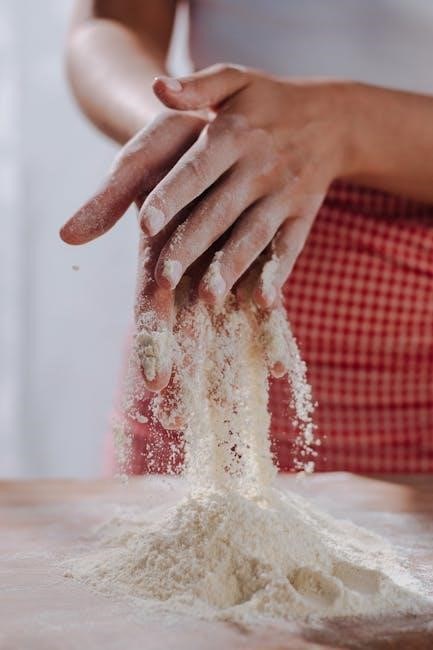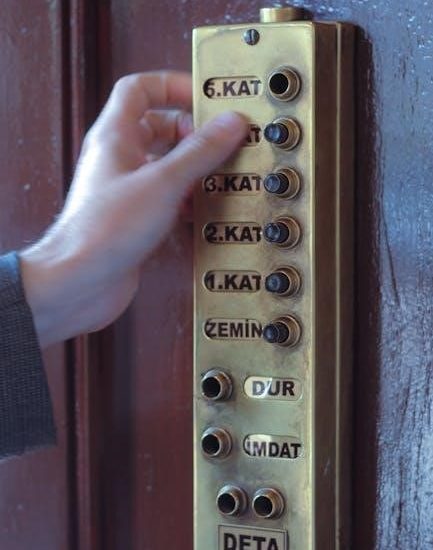permethrin 13.3 mixing instructions
Permethrin 13.3 is a synthetic insecticide belonging to the pyrethroid family, commonly used for pest control in agricultural and household settings. It requires precise mixing for optimal effectiveness and safety.
1.1. What is Permethrin 13.3?
Permethrin 13.3 is a synthetic pyrethroid insecticide, widely used for pest control in agricultural, household, and livestock settings. It is formulated as a concentrated liquid, requiring dilution with water before application. This versatile chemical effectively targets a broad range of pests, including insects, mites, and ticks, making it a popular choice for both indoor and outdoor use. Proper mixing is essential to ensure its efficacy and safety for various applications.
1.2. Common Uses of Permethrin 13.3
Permethrin 13.3 is widely used for controlling insect pests in agricultural settings, livestock, and household environments. It is effective against ticks, mites, and various insects, making it a versatile solution for crop protection, animal treatment, and indoor pest control. Additionally, it is applied in automatic spraying systems for broader coverage and is often recommended for severe infestations due to its strong residual activity and quick knockdown effect on target pests.
1.3. Importance of Proper Mixing
Proper mixing of Permethrin 13.3 is crucial for ensuring its effectiveness and safety. Incorrect ratios can lead to reduced efficacy or potential environmental hazards. Proper emulsion ensures even distribution, preventing separation and maintaining consistent pest control. It also minimizes risks to humans, animals, and plants. Correct mixing procedures guarantee optimal residual activity and quick knockdown of pests, making it essential to follow instructions precisely for desired results and safety.
Safety Measures Before Mixing
Wear PPE, including gloves and goggles, to prevent skin and eye contact. Ensure proper ventilation and avoid inhaling fumes. Keep the area clear of heat sources and ignition risks.
2.1. Personal Protective Equipment (PPE)
Always wear gloves, goggles, and protective clothing when handling Permethrin 13.3 to prevent skin and eye contact. A face mask or respirator is recommended to avoid inhaling fumes. Long sleeves and pants should be worn to minimize exposure. Ensure PPE is chemical-resistant and in good condition. Proper ventilation is essential to prevent the accumulation of vapors. These precautions help safeguard against potential health risks associated with the chemical.
2.2. Handling the Chemical Safely
Handle Permethrin 13.3 in a well-ventilated area, away from heat sources or open flames. Avoid smoking or sparking nearby. Keep the container tightly sealed when not in use. Prevent contamination by ensuring all tools and surfaces are clean. Do not eat, drink, or smoke during handling. Keep the product away from children and pets. Use chemical-resistant gloves to prevent direct contact. Follow all label instructions carefully to minimize risks and ensure safe application.
2.3. Emergency Procedures
In case of skin contact, immediately wash the affected area with soap and water. For eye exposure, flush with clean water for at least 15 minutes. If inhalation occurs, move to fresh air and seek medical attention if symptoms persist. If ingested, do not induce vomiting; contact a poison control center or doctor immediately. For spills, contain the liquid, wear PPE, and neutralize with absorbent material before disposal. Always keep emergency contact numbers handy.

Mixing Ratios for Different Applications
Permethrin 13.3 mixing ratios vary by application, ensuring optimal effectiveness. For general use, mix 2.67 oz per gallon. Heavy infestations require 5.5 oz per gallon. Livestock applications often use 8 oz per 66.5 gallons. Always adjust concentrations based on the target pest and surface type to maintain efficacy and safety. Proper dilution is critical for achieving desired results without overexposure. Adhere to label guidelines for precise measurements.
3.1. General Purpose Applications
For general purpose applications, mix 2.67 ounces of Permethrin 13.3 with 1 gallon of water. This concentration is ideal for handheld pump sprayers, ensuring thorough coverage and effectiveness against a wide range of pests. The solution is suitable for most residential and agricultural uses, providing residual activity for up to 4 weeks. Always ensure the mixture is well-emulsified before application to maintain consistency and potency. Avoid overconcentration, as it may not enhance efficacy and could pose safety risks. Follow label instructions carefully for optimal results.
3.2. Heavy Infestations
For severe infestations, mix 5.5 ounces of Permethrin 13;3 with 1 gallon of water (0.50 dilution). This stronger concentration is recommended for initial cleanup of heavy pest outbreaks. Ensure thorough application to all affected areas, focusing on surfaces where pests are most active. The solution provides effective residual activity for up to 4 weeks. Avoid exceeding the recommended concentration, as it may not improve efficacy and could pose environmental or safety risks. Always follow label guidelines for specific application instructions.
3.3. Livestock and Animal Use
For livestock, mix 8 ounces of Permethrin 13.3 with 66.5 gallons of water for full coverage. For spot treatments, use 2.67 ounces per gallon. This solution controls pests like ticks and flies on cattle, horses, and swine. Dilute 8 ounces in 8.25 gallons for broader applications. Apply using spray or sponge methods, ensuring thorough coverage. Always follow label guidelines to avoid overdosing and ensure animal safety. Proper dilution is key for effective pest control without harming the animals.

Step-by-Step Mixing Instructions
Start by measuring the recommended amount of Permethrin 13.3 concentrate. Add it to water in a well-ventilated area, stirring thoroughly to ensure proper emulsion. Follow specific ratios for accurate mixing.
4.1. Measuring the Concentrate
Accurate measurement of Permethrin 13.3 concentrate is crucial for effective pest control. Use a measuring cup or digital scale to ensure precision. For general-purpose applications, mix 2.67 ounces of concentrate with 1 gallon of water. Always refer to the product label for specific ratios, as concentrations may vary based on the intended use. Proper measurement ensures safety and optimal results, avoiding under-dilution or over-application, which can lead to reduced efficacy or potential environmental harm.
4.2. Combining with Water
After measuring the concentrate, slowly pour it into a partially filled water container. Use a minimum of 1 gallon of water for general-purpose applications. Agitate the mixture thoroughly to ensure the concentrate dissolves completely, forming a uniform emulsion. For heavy infestations, higher concentrations may be required, but always adhere to the recommended dilution ratios to maintain effectiveness and safety. Proper mixing prevents separation and ensures even distribution during application.
4.3. Ensuring Proper Emulsion
After combining permethrin 13.3 with water, ensure the mixture forms a stable emulsion. Use an agitator or stirring stick to mix thoroughly. Check the mixture periodically to confirm it remains uniform. If separation occurs, re-agitate before use. Proper emulsion ensures even distribution of the active ingredient, maximizing effectiveness and preventing uneven application. Avoiding settling or layering is crucial for consistent pest control results. Always maintain agitation during application to keep the emulsion stable.

Application Methods
Permethrin 13.3 can be applied using handheld pump sprayers, automatic spraying systems, or sponge/dip methods. Each technique ensures effective pest control, depending on the target area and infestation severity.
5.1. Handheld Pump Sprayers
Handheld pump sprayers are ideal for small-scale applications of permethrin 13.3. They provide precise control over the amount of solution applied. For general-purpose use, mix 2.67 ounces of permethrin 13.3 with 1 gallon of water to create a 0.25 concentrated solution. Ensure thorough coverage by spraying evenly and maintaining a 12-inch distance from the target surface. This method is portable and effective for residential or agricultural pest control, offering accurate application and minimal waste.
5.2. Automatic Spraying Systems
Automatic spraying systems offer efficient application for large areas. Dilute permethrin 13.3 according to the system’s specifications, typically 8 ounces per 8.25 gallons of water for livestock use. Set nozzles to ensure uniform coverage and adjust pressure for optimal spray distribution. Refer to the system manual for specific instructions to maintain consistency and avoid over-application. This method is ideal for commercial or agricultural settings, ensuring quick and precise treatment of extensive zones with minimal manual intervention required.
5.3. Sponge or Dip Applications
For sponge or dip applications, dilute 8 oz. of Permethrin 13.3 in 16.5 gallons of water, or 1 pint in 33 gallons, or 1 quart in 66 gallons. This method is ideal for direct application on animals or surfaces, ensuring thorough coverage. Dip or sponge the solution evenly, making sure to saturate the target area completely. This technique is particularly effective for treating livestock or specific zones requiring intense pest control, ensuring the solution adheres properly for maximum efficacy.
Reentry and Drying Times
Treated areas can be reentered after the spray has dried. Drying time typically ranges from 1 to 24 hours, depending on environmental conditions like humidity and temperature.
6.1. When Areas Can Be Reentered
Areas treated with Permethrin 13.3 can generally be reentered after the spray has dried. Drying time typically ranges from 1 to 24 hours, depending on environmental conditions such as humidity and temperature. It is crucial to wait until the solution is fully dry to ensure safety and effectiveness. Always check the product label for specific reentry guidelines, as some applications may require a longer waiting period. Proper drying ensures the product adheres correctly and maintains its residual activity.
6.2. Drying Time for Treated Surfaces
The drying time for surfaces treated with Permethrin 13.3 typically ranges from 1 to 24 hours, depending on environmental conditions. Higher humidity and cooler temperatures can extend drying time, while warmer, drier conditions accelerate it. Ensure the solution is completely dry before reentry or further use to maintain effectiveness and safety. Always refer to the product label for specific drying instructions tailored to your application method and environmental factors.
6.3. Factors Affecting Drying Time
The drying time of Permethrin 13.3-treated surfaces is influenced by several factors, including humidity, temperature, and air circulation. Higher humidity and cooler temperatures slow evaporation, extending drying time, while warmer, drier conditions accelerate it. Surface type and application amount also play roles, with porous surfaces and thicker layers taking longer to dry. Additionally, the concentration of the Permethrin mixture can affect evaporation rates. Understanding these factors helps optimize treatment effectiveness and safety.

Storage and Disposal
Store Permethrin 13.3 in a cool, dry place away from heat sources. Dispose of unused product and empty containers according to local regulations. Clean mixing equipment thoroughly after use.
7.1. Proper Storage Conditions
Store Permethrin 13.3 in a cool, dry, well-ventilated area away from direct sunlight and heat sources; Keep the container tightly sealed to prevent contamination. Avoid storing near flammable materials or in areas where temperature extremes may occur. Ensure the product is inaccessible to children and pets. Follow all label instructions for storage to maintain product effectiveness and safety.
7.2. Disposal of Unused Product
Dispose of unused Permethrin 13.3 according to federal, state, and local regulations. Do not discard the product into sewers, waterways, or drainage systems. Check with local waste management facilities for guidance on hazardous waste disposal. Always wear protective gear when handling the product for disposal. Ensure containers are properly sealed and labeled to prevent accidental exposure or misuse. Follow all environmental protection guidelines to minimize ecological impact.
7.3. Cleaning Mixing Equipment
Thoroughly clean mixing equipment after each use to prevent residue buildup. Rinse tanks, hoses, and nozzles with water, ensuring no Permethrin 13.3 remains. Use a mild detergent if necessary. Dispose of rinse water according to local regulations. Regular cleaning prevents contamination of future mixtures and maintains equipment efficiency. Always wear PPE during the cleaning process to avoid exposure. Proper maintenance ensures accurate mixing ratios and effective pest control applications.

Safety Precautions During Mixing
When mixing Permethrin 13.3, wear protective gloves, goggles, and a face mask. Avoid skin contact and inhalation of fumes. Keep the area well-ventilated and away from heat sources or open flames to prevent accidental ignition. Ensure no children or pets are nearby. Immediately wash any contaminated skin with soap and water. In case of spills, contain the area and clean up promptly to prevent environmental contamination. Follow all safety guidelines to minimize risks and ensure safe handling. Proper PPE and ventilation are crucial for protecting against potential health hazards associated with the chemical. Additionally, keep the mixing area clear of any flammable materials and avoid smoking. Regularly inspect equipment for leaks or damage to maintain a safe working environment. Always refer to the product label for specific safety instructions and adhere to them strictly. This ensures not only personal safety but also the effectiveness of the mixture for its intended use. By following these precautions, you can safely prepare Permethrin 13.3 for various applications without compromising your health or the environment. Remember, safety should never be overlooked when working with chemical substances.
8.1. Avoiding Skin and Eye Contact
Wearing protective gloves, goggles, and a face mask is essential to prevent skin and eye contact with Permethrin 13.3. In case of accidental exposure, immediately rinse the affected area with plenty of water. Avoid touching eyes or face during mixing. Prolonged contact can cause irritation or burns. Ensure hands are thoroughly washed with soap after handling the chemical. Preventing direct contact minimizes health risks and ensures safe handling of the insecticide during mixing and application processes.
8.2. Preventing Inhalation of Fumes
When mixing Permethrin 13.3, avoid inhaling fumes by working in well-ventilated areas or using a respirator with an organic vapor cartridge. Ensure the mixing area is free from airflow restrictions. Preventing inhalation minimizes respiratory irritation and potential health risks. Keep the mixture away from direct breathing zones and avoid prolonged exposure to fumes. Proper ventilation and protective equipment are crucial to safely handle the chemical during mixing and application processes.
8.3. Keeping Away from Heat Sources
Permethrin 13.3 should be kept away from heat sources, such as open flames, sparks, or hot surfaces, to prevent accidental ignition. Heat can cause the mixture to degrade or release harmful vapors. Always mix and store the solution in a cool, well-ventilated area. Avoid placing mixing equipment near heaters or ignition sources to ensure a safe working environment. This precaution helps maintain the chemical’s stability and prevents potential fire hazards during handling.

Effectiveness of Permethrin 13.3
Permethrin 13.3 is highly effective against a wide range of pests, offering both residual activity and quick knockdown. Its ability to adhere to surfaces ensures long-lasting control, making it a reliable choice for various applications.
9.1. Residual Activity
Permethrin 13.3 exhibits strong residual activity, providing long-lasting pest control by adhering to surfaces and remaining effective for several weeks. Its dual action—knockdown and residual—ensures prolonged protection against target pests. This makes it particularly effective for outdoor and indoor applications, where repeated exposure to pests is a concern. Proper mixing and application are essential to maximize its residual properties, ensuring consistent pest control over time. The residual effect varies depending on environmental factors like weather and surface type.
9.2. Contact Spray Efficiency
Permethrin 13.3 demonstrates high contact spray efficiency, effectively controlling pests upon direct application. Its quick knockdown action ensures rapid results when applied to target areas or pests. Proper mixing ratios, such as 2.67 ounces per gallon for general use, enhance its efficiency. The product works well in both surface and animal applications, providing reliable pest control when applied thoroughly. This makes it a versatile solution for various pest management scenarios, ensuring optimal performance in agricultural and household settings. Consistent coverage is key to achieving desired results.
9.3. Long-Term Pest Control
Permethrin 13.3 offers extended residual activity, providing long-term pest control for up to four weeks. This ensures continued protection against reinfestation, making it ideal for both indoor and outdoor applications. Its effectiveness persists even after drying, creating a barrier that deters pests from returning. This longevity reduces the need for frequent reapplications, making it a cost-effective solution for managing insect infestations in agricultural and household settings. Proper mixing and application are essential to maximize its residual benefits and ensure sustained pest control.

Alternatives and Comparisons
Permethrin 13.3 is a preferred insecticide due to its effectiveness and residual activity. Alternatives include cypermethrin and deltamethrin, but permethrin 13.3 stands out for its versatility and long-lasting control in various applications.
10.1. Other Insecticides for Similar Use
Other insecticides like cypermethrin and deltamethrin are used for similar pest control purposes. Cypermethrin is known for its rapid knockdown effect, while deltamethrin offers longer residual activity. However, permethrin 13.3 remains a top choice due to its balanced efficacy and cost-effectiveness. These alternatives can be substitutes in formulations but may require different mixing ratios and application methods to achieve desired results. Always follow label instructions for safe and effective use.
10.2. Advantages Over Other Products
Permethrin 13.3 offers several advantages over other insecticides. It provides a rapid knockdown and residual activity, ensuring long-lasting pest control. Its versatility allows application in various settings, including agricultural fields, livestock, and household areas. Additionally, permethrin 13.3 is cost-effective and relatively safe when mixed and applied correctly. These benefits make it a preferred choice for both professional and domestic use, offering a reliable solution for managing a wide range of pest infestations effectively.
10.3. When to Choose Permethrin 13.3
Opt for Permethrin 13.3 when dealing with severe pest infestations, especially in agricultural or livestock settings. Its strong residual activity makes it ideal for long-term pest control. Use it when targeting a wide range of pests, including ticks, mites, and flies. It is particularly effective for outdoor applications and large-scale treatments, where its durability and broad-spectrum efficacy provide superior results compared to other insecticides. This makes Permethrin 13.3 a reliable choice for comprehensive pest management needs.
Common Mistakes to Avoid
Incorrect mixing ratios, improper application techniques, and ignoring safety guidelines are common errors. Always measure concentrate accurately and follow specific instructions for desired effectiveness and safety.
11.1. Incorrect Mixing Ratios
Using the wrong mixing ratio is a frequent mistake, leading to reduced effectiveness or potential environmental harm. Too much concentrate can waste product and pose safety risks, while too little may fail to control pests. Always adhere to recommended ratios, such as 2.67 ounces per gallon for general use or 5.5 ounces for heavy infestations. Double-check measurements and consult the product label to ensure accuracy and safety.
11.2. Improper Application Techniques
Improper application techniques can significantly reduce the effectiveness of Permethrin 13.3. Common mistakes include applying the solution unevenly, not covering the entire target area, or using the wrong equipment. Handheld sprayers may not reach all surfaces effectively, while automatic systems require proper nozzle settings. Additionally, not allowing the solution to dry completely before reentry or exposure to rain can diminish its residual activity. Always follow label instructions for optimal coverage and pest control efficiency.
11.3. Ignoring Safety Guidelines
Ignoring safety guidelines when mixing or applying Permethrin 13.3 can lead to serious health risks, including skin irritation, eye damage, or respiratory issues. Failing to wear PPE, such as gloves and goggles, increases exposure risks. Improper handling, like not avoiding inhalation of fumes, can cause allergic reactions or other adverse effects. Always follow the product label and safety precautions to minimize hazards. Ignoring these guidelines can also result in legal consequences or environmental contamination, emphasizing the importance of responsible use.
Troubleshooting Mixing Issues
Common mixing issues include separation, insufficient coverage, or reduced efficacy. Check dilution rates, re-agitate thoroughly, and ensure proper mixing techniques to resolve these problems effectively.
12.1. Separation of the Mixture
Separation of Permethrin 13.3 mixture can occur if improper dilution rates or insufficient agitation is used. Check the recommended dilution ratio (e.g., 0.25 or 0.50) and ensure thorough mixing. If separation occurs, re-agitate the solution until fully emulsified. Using water with extreme temperatures or poor quality may also cause separation. Always follow the product label for specific instructions to maintain the mixture’s stability and effectiveness. Proper re-agitation ensures consistent application and pest control efficacy.
12.2. Insufficient Coverage
Insufficient coverage can reduce the effectiveness of Permethrin 13.3 treatments. This issue often arises from improper mixing ratios or inadequate application techniques. To ensure complete coverage, always follow the recommended dilution rates (e.g., 0;25 or 0.50) and apply the solution uniformly. Using handheld sprayers or automatic systems correctly helps achieve thorough coverage. Regularly check spray nozzles and equipment to prevent clogging or uneven distribution. Proper coverage ensures maximum pest control and residual activity, making the treatment more effective and long-lasting.
12.3. Reduced Efficacy
Reduced efficacy of Permethrin 13.3 can occur due to improper mixing, such as incorrect dilution ratios or failure to maintain a stable emulsion. This leads to uneven distribution of the active ingredient, lowering its effectiveness against pests. Ensure the concentrate is thoroughly mixed with water, and avoid using contaminated or dirty water, which can destabilize the mixture. Proper mixing and application techniques are crucial for maintaining the product’s potency and ensuring long-lasting pest control and residual activity. Regular agitation during application helps maintain efficacy.


